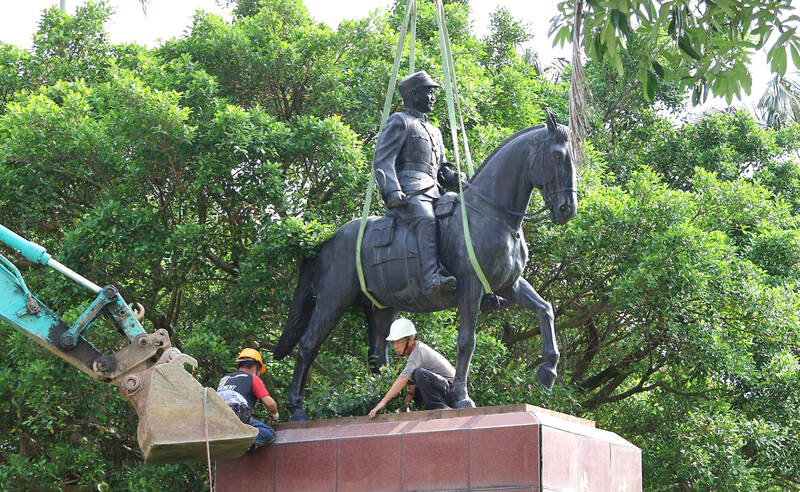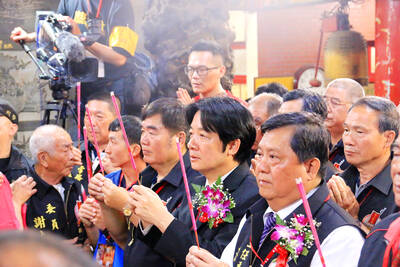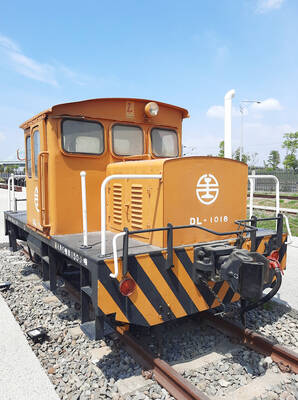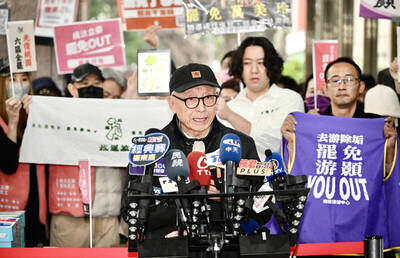The last time Mrs Hsieh came to Cihu Park in Taoyuan was almost 50 years ago, on a school trip to the grave of Taiwan’s recently deceased dictator. Busloads of children were brought in to pay their respects to Chiang Kai-shek (蔣中正), known as Generalissimo, who had died at 87, after decades ruling Taiwan under brutal martial law.
“There were a lot of buses, and there was a long queue,” Hsieh recalled. “It was a school rule. We had to bow, and then we went home.”
Chiang’s body is still there, under guard in a mausoleum at the end of a path that winds through misty bamboo past a still lake broken only by light drizzle and a drifting swan. But the other end of the park is the truly ghostly part, dotted as it is with hundreds of statues, almost all of Chiang.

Photo: Chiang Chih-hsiung, Taipei Times
Some stand in a circle — a group of Chiangs gathered for a casual conference or a campfire chat. Elsewhere, dozens are lined up in what looks like a choir of Chiangs. There is Chiang on a horse, Chiang in a seat, Chiang reading a book or holding a hat. A few have Chiang surrounded by adoring children, and paths are lined with his busts on concrete pedestals. Almost all the Chiangs wear his famous smile.
There were no statues here in the 1970s, says Hsieh. They have been moved here over time, taken from public spaces but not destroyed, standing here as an uncanny honor guard around the mausoleum.
“It’s a strange place,” says Hsieh. “There are so many statues. It would be scary at night.”
.jpg)
Photo: Paul Cooper, Taipei Times
The veneration shown to Chiang when Hsieh was a child is no longer a given. Chiang was the ruler of the Republic of China until he and his Chinese Nationalist Party (KMT) were driven out by the communists in China’s civil war. They and millions of supporters retreated to Taiwan in 1949, establishing the ROC in exile, with Chiang planning to retake China one day. Under his almost-four-decade-rule — now known as the “white terror” — an estimated 3,000-4,000 people were executed and 140,000 imprisoned for actual or perceived opposition to the KMT.
After his death in 1975, Taiwan transitioned to a democracy, and criticism of the leadership present and past became possible. But Chiang’s legacy is still fervently debated here.
In 2018, the ruling Democratic Progressive party (DPP), which was born of the opposition to martial law, established a transitional justice commission to investigate and atone for the KMT’s acts against Taiwan’s people. In 2022, a subsidy program offered grants of up to NT$100,000 for local authorities to change or remove “authoritarian symbols” to help end a “culture of political veneration.”
Taiwan has more than 300 roads named after Chiang, almost 60 schools and dozens of localities, including the central district of Taipei. A handful have changed name in the past five years: a road in former capital Tainan is now named after a prominent victim of the massacre of February 1947, when thousands of protesters were killed by KMT troops.
Last week, a DPP legislator challenged the government on its slow progress over the more than 700 statues that are still standing, saying it should be more proactive in encouraging take-up of the subsidies. Shih Pu (石樸), an official with the Executive Yuan’s Department of Human Rights and Transitional Justice, said part of the issue was that many of the statues were on military sites, which did not want to remove them.
The modern KMT, now in opposition, has apologized for past acts but opposes the DPP’s transitional justice efforts, which it says amount to a political witch-hunt. Some members have likened a proposal to remove the largest Chiang statue — a six-meter-high sculpture in central Taipei — to the Taliban’s destruction of the Buddhas of Bamiyan in 2001.
Opinions are divided but nuanced. Prominent campaigner Lin Lee-tsai , whose father was a victim of the massacres, said her family will “set off firecrackers” if the Taipei statue is removed. But some say Chiang’s crimes must be balanced against the economic boom he ushered through, and his fight against the Japanese and the communists.
“Chiang did a lot of controversial things,” park visitor Mr Huang said. “But he also made contributions. If he hadn’t come to Taiwan back then, it would probably be ruled by the communists now, and most Taiwanese do not want to be governed by Xi Jinping (習近平).”
Hsieh says there’s no point erasing history, and the statues look OK where they are in schools. Also, she adds, laughing, Cihu park is spooky enough. It doesn’t need any more.

The Democratic Progressive Party (DPP), Chinese Nationalist Party (KMT), and the country’s other political groups dare not offend religious groups, says Chen Lih-ming (陳立民), founder of the Taiwan Anti-Religion Alliance (台灣反宗教者聯盟). “It’s the same in other democracies, of course, but because political struggles in Taiwan are extraordinarily fierce, you’ll see candidates visiting several temples each day ahead of elections. That adds impetus to religion here,” says the retired college lecturer. In Japan’s most recent election, the Liberal Democratic Party lost many votes because of its ties to the Unification Church (“the Moonies”). Chen contrasts the progress made by anti-religion movements in

Taiwan doesn’t have a lot of railways, but its network has plenty of history. The government-owned entity that last year became the Taiwan Railway Corp (TRC) has been operating trains since 1891. During the 1895-1945 period of Japanese rule, the colonial government made huge investments in rail infrastructure. The northern port city of Keelung was connected to Kaohsiung in the south. New lines appeared in Pingtung, Yilan and the Hualien-Taitung region. Railway enthusiasts exploring Taiwan will find plenty to amuse themselves. Taipei will soon gain its second rail-themed museum. Elsewhere there’s a number of endearing branch lines and rolling-stock collections, some

Last week the State Department made several small changes to its Web information on Taiwan. First, it removed a statement saying that the US “does not support Taiwan independence.” The current statement now reads: “We oppose any unilateral changes to the status quo from either side. We expect cross-strait differences to be resolved by peaceful means, free from coercion, in a manner acceptable to the people on both sides of the Strait.” In 2022 the administration of Joe Biden also removed that verbiage, but after a month of pressure from the People’s Republic of China (PRC), reinstated it. The American

This was not supposed to be an election year. The local media is billing it as the “2025 great recall era” (2025大罷免時代) or the “2025 great recall wave” (2025大罷免潮), with many now just shortening it to “great recall.” As of this writing the number of campaigns that have submitted the requisite one percent of eligible voters signatures in legislative districts is 51 — 35 targeting Chinese Nationalist Party (KMT) caucus lawmakers and 16 targeting Democratic Progressive Party (DPP) lawmakers. The pan-green side has more as they started earlier. Many recall campaigns are billing themselves as “Winter Bluebirds” after the “Bluebird Action”